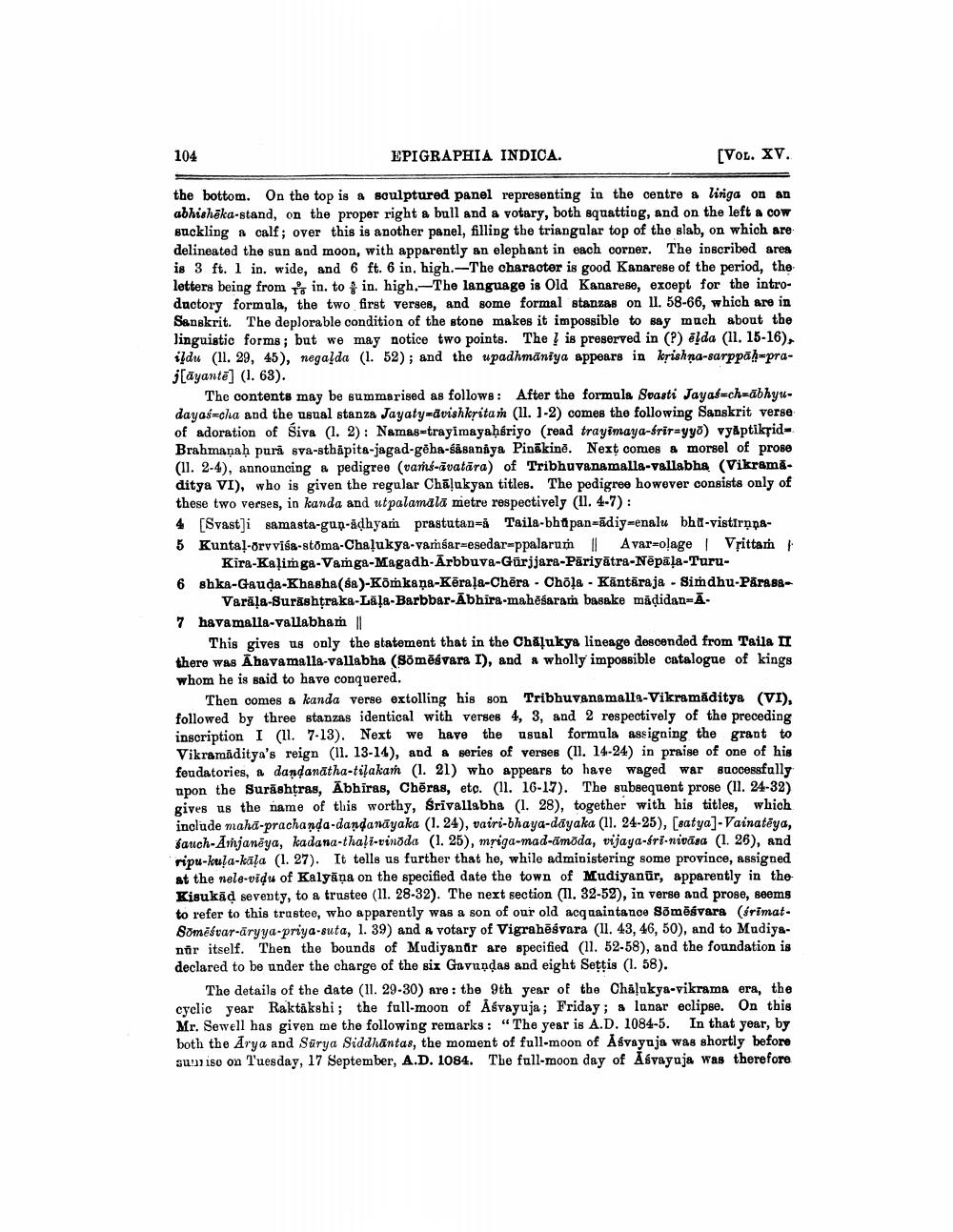________________
104
EPIGRAPHIA INDICA.
[VOL. XV.
the bottom. On the top is a sculptured panel representing in the centre a linga on an abhisheka-stand, on the proper right a bull and a votary, both squatting, and on the left a cow suckling a calf; over this is another panel, filling the triangular top of the slab, on which are delineated the sun and moon, with apparently an elephant in each corner. The inscribed area is 3 ft. 1 in. wide, and 6 ft. 6 in. high.-The character is good Kanarese of the period, the letters being from in. to in. high. The language is Old Kanarese, except for the introductory formula, the two first verses, and some formal stanzas on 11. 58-66, which are in Sanskrit. The deplorable condition of the stone makes it impossible to say much about the linguistic forms; but we may notice two points. The is preserved in (?) elda (11. 15-16), ildu (11. 29, 45), negalda (1. 52); and the upadhmaniya appears in krishna-sarppaḥ-prajayante] (1. 63).
The contents may be summarised as follows: After the formula Svasti Jayas-ch-abhyudayas-cha and the usual stanza Jayaty-avishkritam (11. 1-2) comes the following Sanskrit verse of adoration of Siva (1. 2): Namas-trayimayaḥsriyo (read trayimaya-frir=yyō) vyaptikṛid= Brahmaṇaḥ pura sva-sthäpita-jagad-geha-sasanaya Pinākině. Next comes a morsel of prose (11. 2-4), announcing a pedigree (vams-avatara) of Tribhuvanamalla-vallabha (Vikramaditya VI), who is given the regular Chalukyan titles. The pedigree however consists only of these two verses, in kanda and utpalamala metre respectively (11. 4-7):
4 [Svasti samasta-gun-adhyam prastutan-a Taila-bhapan-adiy-enalu bhi-vistirnpa5 Kuntal-orvvisa-stoma-Chalukya-vamsar-esedar=ppalarum || Avar-olage | Vrittam |
Kira-Kalimga-Vamga-Magadh-Arbbuva-Gürjjara-Pariyātra-Nēpāļa-Turu
6 shka-Gauḍa-Khasha (sa)-Kömkana-Kerala-Chēra Chōla Kantāraja - Simdhu-ParasaVarala-Surashṭraka-Lala-Barbbar-Abhira-mahesaram basake maḍidan-A
7 havamalla-vallabham ||
This gives us only the statement that in the Chalukya lineage descended from Taila II there was Ahavamalla-vallabha (Sōmesvara I), and a wholly impossible catalogue of kings whom he is said to have conquered.
Then comes a kanda verse extolling his son Tribhuvanamalla-Vikramaditya (VI), followed by three stanzas identical with verses 4, 3, and 2 respectively of the preceding inscription I (11. 7-13). Next we have the usual formula assigning the grant to Vikramaditya's reign (11. 13-14), and a series of verses (11. 14-24) in praise of one of his feudatories, a dandanatha-tilakam (1. 21) who appears to have waged war successfully upon the Surashtras, Abhiras, Cheras, etc. (11. 16-17). The subsequent prose (11. 24-32) gives us the name of this worthy, Srivallabha (1. 28), together with his titles, which include maha-prachanda-dandanayaka (1. 24), vairi-bhaya-dayaka (11. 24-25), [satya]-Vainateya, sauch-Amjaneya, kadana-thali-vinoda (1. 25), mriga-mad-ämoda, vijaya-sri-nivasa (1. 26), and ripu-kula-kala (1. 27). It tells us further that he, while administering some province, assigned at the nele-vidu of Kalyana on the specified date the town of Mudiyanür, apparently in the Kisukaḍ seventy, to a trustee (11. 28-32). The next section (11. 32-52), in verse and prose, seems to refer to this trustee, who apparently was a son of our old acquaintance Somesvara (śrimatSomesvar-äryya-priya-suta, 1. 39) and a votary of Vigrahesvara (II. 43, 46, 50), and to Mudiyanar itself. Then the bounds of Mudiyantir are specified (11. 52-58), and the foundation is declared to be under the charge of the six Gavundas and eight Seṭṭis (1.58).
The details of the date (11. 29-30) are: the 9th year of the Chalukya-vikrama era, the cyclic year Raktakshi; the full-moon of Asvayuja; Friday; a lunar eclipse. On this Mr. Sewell has given me the following remarks: "The year is A.D. 1084-5. In that year, by both the Arya and Surya Siddhantas, the moment of full-moon of Asvayuja was shortly before sumiso on Tuesday, 17 September, A.D. 1084. The full-moon day of Asvayuja was therefore




